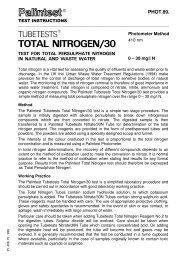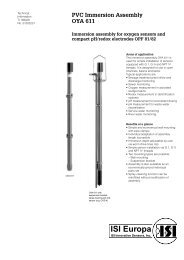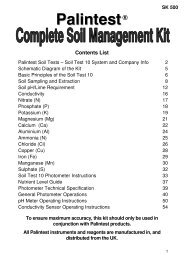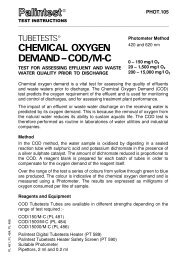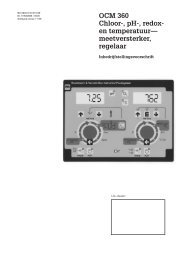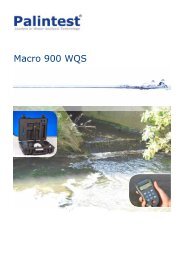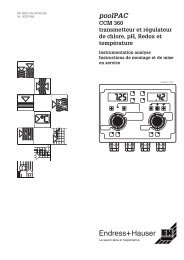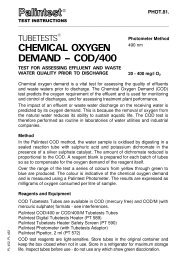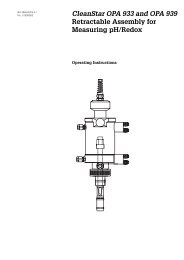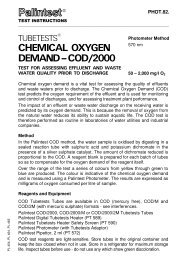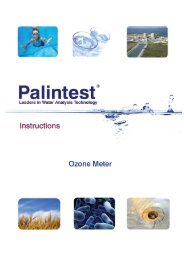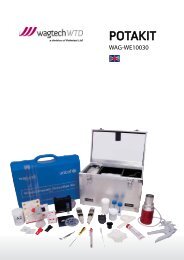LMI ELECTRONIC DOSING PUMPS Code : P1
LMI ELECTRONIC DOSING PUMPS Code : P1
LMI ELECTRONIC DOSING PUMPS Code : P1
Create successful ePaper yourself
Turn your PDF publications into a flip-book with our unique Google optimized e-Paper software.
<strong>LMI</strong> <strong>ELECTRONIC</strong> <strong>DOSING</strong> <strong>PUMPS</strong><strong>Code</strong> : <strong>P1</strong>Basic manualInstruction supplement / Liquid end SheetSpare parts list for drive assemblyDeclaration « CE » of conformityList of « Technical assistance » and « spare parts » departmentsGB
INSTRUCTION MANUALFOR INSTALLATION,OPERATING,AND MAINTENANCE.<strong>LMI</strong> <strong>ELECTRONIC</strong> <strong>DOSING</strong> <strong>PUMPS</strong>Diaphragm liquid endBasic manualThis manual should be made available to the person responsible for installation,operating and maintenance.Date : 10/98Replaces Rev. 0 07/98Ref : 160.0101.001 Rev. B
CONTENTSI – DESCRIPTIONI – 1. UnpackingI – 2. DescriptionI – 3. AccessoriesI – 4. PrecautionsII – INSTALLATIONIII – START UPII – 1. Hydraulic installationII – 2. Electrical installationIII – 1. PrimingIII – 2. Output adjustment controlsIII – 3. CalibrationIII – 4. Volumetric calibration in external modeIII – 5. Pressure controlIV – MAINTENANCEIV – 1. Spare parts replacementsIV – 2. Checking pump for proper zeroing (stroke knob)IV – 3. TroubleshootingIV – 4. EPU Resistance chart<strong>LMI</strong>, Doseur à membrane, L001, Rev.B, 1098
PART I – DESCRIPTIONThis manual addresses the installation, maintenance and troubleshooting procedures for electronic dosing pumps. Aninstruction supplement and a liquid end sheet complete this manual.Please read them carefully before installing your pump.I – 1. UNPACKINGThe packaging must be carefullyexamined on receipt in order toensure that the contents have notsustained any obvious damage.The carton contains the itemsnecessary to a proper installation.Dosing pump Function valve * Ceramic weight** depending on modelTubing Injection check valve* Foot valve*I - 2 - DESCRIPTIONYour pump consists of two parts :1. The drive assembly2. The liquid handling assemblyThe pump code which appears onthe packaging and on theidentification plate consists of twocodes according to drive assemblytype and liquid handling assemblytype.DRIVEA753LIQUID HANDLING ASSY352SMI - 1<strong>LMI</strong>, Doseur à membrane, L001, Rev.B, 1098
Output adjustment controlsAccording to pump type, output adjustment controls areavailable :• Stroke adjustmentEach pump is equipped with a stroke adjustment.Stroke control provides adjustment of percent ofmaximum diaphragm travel.Note : For B & C Series, stroke adjustment only whenpump is running.• Speed adjustmentA1, A7, B1, B7, C1, C7, J5, <strong>P1</strong> Series pumps areequipped with a speed adjustment. Speed controlprovides adjustment of the percent of maximum strokesper minute.• Pressure control adjustmentB7 and C7 Series Pumps are equipped with a pressurecontrol adjustment. Pressure control provides theadjustment of the pump’s pressure capability and powerconsumption, reducing heat, pipe shock and pulsation.For more details, refer to Instruction supplementI - 3. ACCESSORIES4-Function valveThis accessory is supplied as standard equipment or asoption. The functions are :1. Anti-syphon (automatic)Prevents syphoning when pumping downhill or into avacuum.2. Back pressure (automatic)Supply approximately 1,7 bar back pressure to preventover pumping when little or no system back pressure ispresent.3. Priming (manual)Prime your pump while it is connected to a pressurizedline.4. Line depressurization (manual)By pulling both knobs (yellow and black) the dischargeline will drain back to your supply tank.3-Function valveThis accessory is supplied as standard equipment or asoption (according to Series 300 models). The functionsare :1. Priming (manual)Prime your pump while it is connected to a pressurizedline.2. Pressure relief (automatic)Provides protection against excessive system pressure.3. Line depressurization (manual)By opening the relief valve, the discharge line willdepressurize without having loosen or disconnectdischarge tubing.Bleed/4-Function valveThis accessory is supplied as standard equipment or asoption (according to Series 300 models). The functionsare :I - 21. Anti-syphon (automatic)Prevents syphoning when pumping downhill orinto a vacuum.2. Back pressure (automatic)Supply approximately 1,7 bar back pressure toprevent over pumping when little or no systemback pressure is present.3. Continuous bleed (automatic)This valve is designed to permit an adjustable,continuous bleed or degasing or entrappedvapors. It is ideal for pumping small volumes ofsolutions having low vapor pressures.4. Line depressurization (manual)By opening bleed port, the discharge lline willdepressurize, without having to loosen tubing orfittings.Foot valve(Accessory available according to the model)The foot valve makes easier priming and keep thepump primed in suction lift applications.The strainer prevents sediment to pass through andvalves to clog.Injection check valveCanne d’injectionThe injection check valve prevents backflow from atreated line.I – 4. PRECAUTIONSAlways wear protective clothing, face shield, safetyglasses and gloves when working on or near yourmetering pump.All <strong>LMI</strong> pumps are shipped from factory with waterin pump head to make easier priming.If the pump head is empty, refill it with water orsolution compatible with pumped solution beforestarting up the pump (see note on the Liquid EndSheet).Solution compatibilityVerify that the liquid handling components arecompatible with the pumped solution (refer to LiquidEnd Sheet).Make certain that all tubing is securely attached tofittings prior to start-up.Tubing supplied allows to match with pumpmaximum specifications.All fittings should be hand tightened.Overtighteningor use of a pipe wrench can cause damage to thefittings, causing the pump to lose prime or notfunction.All <strong>LMI</strong> pumps have straight ¾’’- 16N or 7/8 ’’- 14Nor 1"- 12 N machine threads on the head andfittings.The seal rings prevent leaks. Do not use Teflon tapebetween fittings and pump head.<strong>LMI</strong>, Doseur à membrane, L001, Rev.B, 1098
PART II – INSTALLATIONII – 1. HYDRAULIC INSTALLATIONThe pump can be mounted in one of two ways :• Flooded suction (ideal installation).• Suction lift – when suction lift is less than 1,5 m forsolutions having a specific gravity of water. Your<strong>LMI</strong> metering pump must be mounted so that thesuction and discharge valves are vertical.Flooded suctionThe pump is mounted at the base of the storage tank.This installation is the most trouble-free, and isrecommended for very low outputs, solutions thatgasify, and high viscosity solutions. (Install shut offvalve on the tank).1 Solution tank 9 Vent4 Pump 10 Tee8 Injection check valveFig. 2.1a : Flooded suctionSuction lift• Wall bracket mount. The pumpmay be mounted directly above thesolution tank. A pump mounted inthis manner allows for easychanging of solution tank.1 Solution tank4 Pump6 Pressure line8 Injection check valve10 TeeA 50 mm space forsediment accumulationII - 1Fig. 2.1b : Suction lift<strong>LMI</strong>, Doseur à membrane, L001, Rev.B, 1098
• Tank mount. The pump may bemounted on a molded tank. Tanksfrom 60 to 1000 liters are availablefor this utilisation.1 Solution tank2 Foot valve (equippedwith strainer)4 Pump6 Flow8 Injection check valve10 Te11 Ceramic weightA 50 mm space forsediment accumulationFig. 2.1c : Tank mount• Shelf mount (customer supplied).The pump may be mounted on ashelf. An <strong>LMI</strong> mounting kit isavailable for securing the pump toa shelf. (Series A , B, C).1 Solution tank2 Foot valve (equippedwith strainer)4 Pump6 Flow8 Injection check valve10 Te11 Ceramic weightA 50 mm space forsediment accumulationFig. 2.1d : Shelf mountII - 2<strong>LMI</strong>, Doseur à membrane, L001, Rev.B, 1098
Pump locationLocate pump in an area convenient to solution tank andelectrical supply.The pump should not be subjected to ambienttemperatures above 50°C. Avoid exposing to directsunlight the pump.Tubing connections• For installation and trouble-free running, use onlyrecommended tubing size (refer to spare parts list).• Do not use clear vinyl tubing on the discharge sideof the pump. The pressure created by the pump canrupture the vinyl tubing.• Before installation, all tubing must be cut with aclean square end.• Remove the plugs which protect the headconnections and valves.• Do not use pliers or pipe wrench on coupling nuts orfittings.• When tubing connection fits on a cone, dip end inhot water.Refer also to the Liquid End Sheet.Foot valve/Ceramic weightThe foot valve must be sit in a vertical position at thebottom.Position approximately 50 mm off the bottom if the tankor drum contains sediment.The ceramic weight positions the foot valve in a verticalposition.Refer to the Liquid End Sheet for details of connections.1 Solution tank 4 Pump2 Foot valve 11 Ceramic weightFig. 2.2a : Foot valve/Ceramic weightInjection check valveCanne d’injectionConnect the injection check valve to your discharge(outlet) line (refer to the Liquid End Sheet).For in-line injection, use fitting or pipe tee with reducingbushing to ½’’ (12x17).Use Teflon tape or pipe dope to seal the pipe threadsonly.When installing the injection check valve, be sure toposition it so that the valve enters the botton of yourpipe in a vertical position (see fig. 2.2b).Variations left and right within 30° are acceptable.For low pressure (under 1,7 bar) or open tank use, theinjection nozzle prevents siphoning but not flowincrease.In this case,we recommend the use of a 4-Functionvalve.Refer to the Liquid End Sheet for details of connections.II - 3<strong>LMI</strong>, Doseur à membrane, L001, Rev.B, 1098
8 Injection check valve B Use Teflon tape10 Tee C Do not use Teflon tape12 Reducing bushing ½ ‘’ D ± 30° variation acceptable13 Pipe cross sectionFig. 2.2b : Injection check valveII – 2. ELECTRICAL INSTALLATIONCheck the specifications of the pump and comparethem with the voltage available on your installationbefore making connections.WARNING :To reduce the risk of electrical shock, the meteringpump must be plugged into a fused grounded outletwith ratings conforming to the pump specification chart(see Technical characteristics : refer to peak power todetermine the appropriate fuse size).DO NOT USE ADAPTERS.All wiring must be conform to local electrical codes.OVER-VOLTAGE<strong>LMI</strong> pumps include a Varistor vonnected on the supplyvoltage terminals.This device is an over-voltage protection. It will burn ifthe supply voltage exceeds 150 V for 115 V ratedpumps or 275 V for 230 V rated pumps to protect thepulser.As soon as it happends, it means the pump got a toohigh voltage peak. After supply voltage control, replacethe Varistor and the pump will run again.II - 4<strong>LMI</strong>, Doseur à membrane, L001, Rev.B, 1098
PART III – START UPPumps are shipped from the factory with water in thepump head to aid in priming. After a long storage, refillthe pump head with water or solution compatible withpumped solution (see note on the Liquid End Sheet).7. The volume and the time unit are known. Calculatethe output. If the output is too low or too great, adjustspeed and or stroke, estimating required correction.8. Adjust stroke length knob to desired value refering tocalibration.III – 1. PRIMINGAfter connecting the pump, plug in or switch the pumpon. While the pump is running, set the speed knob at80% and the stroke knob at 100%. If the pump isequipped with a pressure control knob (B7, C7), set theswitch on « INTERNAL » and turn the pressure controlknob fully clockwise.III – 2. OUTPUT ADJUSTMENTCONTROLSOnce the pump has been primed, an appropriate outputadjustment must be made.The identification plate indicates the output at max.stroke and max. speed (100%) and max. pressure. Thegraduations of stroke knob and speed knob correspondto percentage of this max. output.Note : P0 pumps have no stroke adjustment.Example :Use max. output = 2,3 L/H. If the pump is set at 40%speed and 60% stroke lenght, the appropriate pump output is 2,3 L/H x 0.40 x 0.60 = 0,55 L/H.Note : Remember that 6x8 tubing is 0,22 ml/cm which is0,8 % wrong for 1 l measuring pot.2 Foot valve 10 Tee4 Pump 14 Graduate container(1 l min.)6 Pressure line E Suction lift8 Inj. check valveFig. 3.2a : CalibrationIII – 3. CALIBRATIONOnce installation is complete and the approximateoutput has been determined, the pump should becalibrated to adjust speed and stroke for your actualdesired output.1. If equipped (B7 – C7 series), make certain Pressurecontrol knob is turned fully clockwise.2. Be sure the pump is in normal service (i.e. includingfactors such as injection pressure, fluid viscosity,suction lift …).3. Place the foot valve in a graduated container.4. Start the pump at maximum frequency and let it runto remove air trapped in suction line (bleed valveopen when using a 4FV). Close bleed after priming.5. Turn the pump off. Refill graduated container to alevel strarting point.6. Using a stopwatch or timer, turn the pump on for ameasured amount of time (50 pump strokesminimum). The longer the time period, the moreconfident you can be of the results.III - 1<strong>LMI</strong>, Doseur à membrane, L001, Rev.B, 1098
III – 4. VOLUMETRIC CALIBRATION INEXTERNAL MODE1. Since pump output is governed by an external devicesuch as Flowmeter-pulser, Liquitron Current-tofrequencyconverter or 4-20 mA DC signal from aninstrument with an <strong>LMI</strong> Analog-to-digital converter,only the ouptut per stroke may be calibrated.2. With pump primed and discharge tubin connected tothe injection point as it would be in normal service,place foot valve in a graduated container.3. Swtch pump to Internal mode with speed knob set at100 until air is exhausted from suction line and pumphead.4. Adjust control pressure (B7 – C7 series).5. Turn the pump off. Refill graduated container to alevel strarting point.6. Switch pump on and count the number of strokes.For a good accuracy, count at least 100 strokes.Switch pump off.7. Note the volume pumped during the calibrationperiod and the number of strokes. Divide into thevolume the number of strokes to determine thevolume of solution pumped per stroke.8. Adjust stroke length knob to desired value refering tocalibration.III – 5. PRESSURE CONTROLAdjust pressure control (B7 - C7 series) : while unit isrunning, turn pressure control knob fully clockwise thenturn slowly counter-clockwise until unit just begins tostall. This is the optimmum pressure control setting foryour installation. Adjust pressure control to prolongpump life.Increase setting if back pressure is increased.F : Excess pressureFig. 3.3a : Control pressureNote : On series A9, B9, C9, this setting is in the mainmenu.III - 2<strong>LMI</strong>, Doseur à membrane, L001, Rev.B, 1098
PART IV – MAINTENANCEIV – 1. SPARE PARTSREPLACEMENTSWARNING : Always wera protective clothing, faceshield, safety glasses and gloves when performing anymaintenance or replacement on your pump.<strong>LMI</strong> metering pumps are designed for trouble-freeoperation, yet routine maintenance of elastomeric partsis essential for optimmum performance.Refer to the spare parts list.Replacements frequency will depend on your particularapplication. We recommend replacing these parts atleast one a year.Diaphragm replacement1. Depressurize the pump (see Liquid End Sheet).2. Place the foot valve into a container of water or otherneutralizing solution.Turn the pump on to flush the head assembly. Lift thefoot valve out of the solution and continue to pumpair into the pump head until the pump head is purgedof water or neutralizing solution. If the liquid cannotbe pumped due to diaphragm rupture, usingprotective gloves, carefully disconnect the suctionand discharge tubing. Remove the screws to thehead and immerse the head in water or otherneutralizing solution.3. While running, set the stroke knob to zero and turnthe pump off.4. Dismantle the liquid end. Unscrew the diaphragm.Clean the diaphragm recess and the disk. Check thesize of replacement diaphragm, the code (0,5 - 0,9 -1,8 - 3,0- 6,0) is indicated on the diaphragm and thedisk or spacer (see fig. 4.1a).5. Reinstall the disk (A, J, P series).6. Start the pump and turn the stroke knob to the settingindicated on stroke setting chart which matches thepump model number located on the pump dataplate.Stop the pump.7. Grasp the outer edge of the diaphragm and adjust byscrewing it in or out so that the center of thediaphragm is flush with the outside of the spaceredge (see fig. 4.1b). Once the diaphragm is properlypositionned, remount the pump head to the spacerusing the screws. Tighten in a crisscross pattern.AFTER ONE WEEK OF OPERATION, RECHECKTHE SCREWS AND TIGHTEN IF NECESSARY.16 Diaphragm 18 <strong>Code</strong>17 SpacerFig. 4.1a : Diaphragm identification15 Straight edge G Gap16 Diaphragm H No gap17 SpacerPump seriesA – B – J – P (all series)Cx0 – Cx1 – Cx2Ex0 – Ex1 – Ex2Fig. 4.1b : Diaphragm fittingStroke knob setting90 %Cx3 – Cx4 – Cx5Ex3 – Ex470 %IV - 1<strong>LMI</strong>, Doseur à membrane, L001, Rev.B, 1098
Ball, seal ring and injection check valve springreplacement or set of cartridges replacement(depending on model)Refer to the spare parts list for the proper sparte partskit number.1. Depressurize the pump (see Liquid End Sheet).2. Flush and purg the pump head before dismantling(see above).3.During dismantling, note the orientation of each item.4. Dismantling the injection check valve. Unscrew thevalve body and replace the spring, the ball and theseal ring. Refer to the spare parts list drawing.5. Replace the seal rings and balls in the pump headand the foot valve. Order of assembly changesdepending on valve location.6. In case of cartridge liquid end, see spare parts listdrawing to identify the orientation of each item.IV – 2. CHECKING PUMP FOR PROPERZEROING (STROKE KNOB)1. With pump running, turn stroke knob counterclockwisetoward zero or end of black or red band.2. Listen to the clicking as the pump is running. Thepump shoukd operate quietly at the zero position (noclicking). If the pump continues to click at zero orstops clicking before zero is reached, the pump zeromust be reset.Push on knob1. Remove stroke knob from the pump by grasping theknob firmly and pulling it toward you.2. Pry off the yellow cap.3. Place the knob on a flat surface.4. Using needle nose pliers, squeeze the inner sectiontogether while lifting the outer section up.5. Push the inner section back onto the « D » shapedstroke shaft.6. With the pump running, zero the pump by turning theinner sectionof the knob counter-clockwise until thepump stops clicking.7. Position the outer section of the knob so that thepointer aligns with zero on the nameplate or end ofthe black or red band.8. Push down on the outer section (a snap soundindicates parts are locked together).9. Replace the yellow cap over the outer section of theknob, aligning the tabs on the cap with the slotsinside the knob.20 Shaft 22 Knob base21 Knob pointer 24 Knob pointerFig. 4.2a : Push on knobIV - 2<strong>LMI</strong>, Doseur à membrane, L001, Rev.B, 1098
IV – 3. TROUBLESHOOTINGPump will not prime• Pump not turned on or plugged in.Turn on pump/plug in pump.• Output dials not set properly.Always prime pump with speed at 80 % and strokeat 100 %.• Foot valve not in vertical position on bottom of tank.See Chapter II – 1. Section Foot valve/ceramicweight.• Pump suction lift too high.Maximum suction lift is 1,5 m. Pump with Highviscosity liquid handling assemblies require floodedsuction.• Suction tubing is curved or coiled in tank.Suction tubing must be vertical. Use ceramic weightsupplied with pump. (see Chapter II – 1. SectionFoot valve/ceramic weight).• Fittings are over tightened.Do not overtighten fittings. This causes seal rings todistort and not seat propertly which causes pump toleak back or lose prime.• Air trap in suction valve tubing.Suction tubing should be as vertical as possible.AVOID FALSE FLOODED SUCTION (see ChapterII – 1. Section Flooded suction).• Too much pressure at discharge (pump without 4-function valve).Shut off valves in pressurized line. Disconnecttubing at injection check valve (see Chapter III – 1.Priming). When pump is primed, reconnectdischarge tubing.Pump loses prime• Solution container ran dry.Refill container with solution and reprime (see PartIII).• Foot valve not in vertical position on bottom of tank.See Chapter II – 1. Section Foot valve/ceramicweight.• Pump suction lift too high.Maximum suction lift is 1,5 m. Pump with Highviscosity liquid handling assemblies require floodedsuction.• Suction tubing is curved or coiled in tank.Suction tubing must be vertical. Use ceramic weightsupplied with pump. (see Chapter II – 1. SectionFoot valve/ceramic weight).• Fittings are over tightened.Do not overtighten fittings. This causes seal rings todistort and not seat propertly which causes pump toleak back or lose prime.• Air trap in suction valve tubing.Suction tubing should be as vertical as possible.AVOID FALSE FLOODED SUCTION (see ChapterII – 1. Section Flooded suction).• Air leak on suction side.Check for pinholes, cracks. Replace if necessary.Leakage at tubing• Worn tubing ends.Cut tubing about 25 mm (1’’) off tubing and thenreplace as before.• Loose or crack fitting.Replace fitting if cracked. Carefully hand tightenfittings. Do not use pipe wrench. Once fitting comesinto contact with seal ring, tighten an additional 1/8or ¼ turn.• Worn seal rings.Replace balls and seal rings (see part IV).• Solution attacking Liquid handling assemblymaterial.Consult Technical Assistance Department foralternate materials compatible with the pumpedsolution.Low output or failure to pump againstpressure• Pump’s maximum pressure rating is exceeded byinjection pressure.Injection pressure cannot exceed pump’s maximumpressure. See pump data plate.• Worn seal rings.Replace them : see Chapter IV –1.• Ruptured diaphragm.Replace diaphragm : see Chapter IV –1. SectionDiaphragm replacement.• Incorrect stroke length.Check zero on pump/Re-zero pump (See ChapterIV – 2.).• Tubing run on discharge may be too long.Longer tubing runs may create frictional lossessufficient to reduce pump’s pressure rating.• Clogged foot valve strainer.Remove foot valve strainer when pumping slurriesor when solution particles cause strainer to clog.Failure to run• Pump not turned on or plugged in.Turn on or plug in pump. Check also programming(A9, B9, C9 Series).• EPU failure.Disassemble pump and measure the resistance ofthe EPU across the EPU wires. Resistance readingshould be in accordance to the table (see ChapterIV – 4.). Also check EPU leads to ground.• Pulser failure.The pulser should be replaced if EPU checks outOK.IV - 3<strong>LMI</strong>, Doseur à membrane, L001, Rev.B, 1098
Excessive pump output• Syphoning. Pumping downhill without a 4-FV.Move injection point to a pressurized location orinstall an 4-FV.• Little or no pressure at injection point.If pressure at injection point is less than 1,5 bar (25psi), an 4-FV should be installed.• Excessive strokes per minute.Replace pulser or control panel.IV – 4. EPU RESISTANCE CHARTPump series Voltage Coil resistance (ohms)20° C (68°F)Ax4, Ax5, Ax6 115 V 76 – 87Px4, Px5, Px6, Px8230 V 307 – 353H9Ax7, Ax8 115 V 152 – 176Px2, Px3 230 V 583 – 671Bx1, Bx2, Bx3, Bx4 115 V 43 –49230 V 167 – 193Cx0, Cx1, Cx2, Cx3, Cx4, Cx5 115 V 22.8 – 26,2E70, E71, E72, E73, E74 230 V 91 – 105J54D, J55D, J56D 12VDC 1.1 – 1.3IV - 4<strong>LMI</strong>, Doseur à membrane, L001, Rev.B, 1098
Instruction Supplement<strong>LMI</strong> PUMP SERIES <strong>P1</strong>1 Foot valve 9 Injection check valve2 Ceramic weight 10 Discharge tubing3 Suction tubing 11 Spacer E.P.U.4 Suction fitting 12 Metering pump housing5 Return line (pressure relief) 13 Speed knob6 Pump head 14 Stroke knob7 4-Function valve (option) 15 Power cord8 Coupling nutMetering pump component diagramDate : 10.98Replaces Rev. 0 , 07.98REF. : 161.5304.001 Rev. A
1 Identification plate2 Stroke knob3 Speed knob4 Stroke lightControl panel detail1 Potentiometer2 Stroke led3 Pulser assembly4 Power cord5 Mov/cap assembly6 EPU assembly23 <strong>P1</strong>2x, <strong>P1</strong>3x : cut 1 resistorOther <strong>P1</strong> : leave both resistorsBLU BlueBRN BrownGRN/YEL Green/yellowYEL YellowWiring diagram<strong>LMI</strong> PUMP SERIES <strong>P1</strong> 2/3
TECHNICAL CHARACTERISTICSNote :<strong>P1</strong>2x <strong>P1</strong>3x <strong>P1</strong>4x <strong>P1</strong>5x <strong>P1</strong>6x <strong>P1</strong>8xOutput- max. (l/h)- min (ml/h)0.752.251.64.82.24.43.87.67.615.21224Max. pressure (bar) 10.3 7.6 17.3 7.6 3.5 1.5Stroke capacity (ml)- min.- max.0.070.220.130.440.070.370.130.630.251.270.402.00Stroke frequency (cps/mn)- min.- max.1601601100110011001100Diaphragm size (in 2 ) 0.5 0.9 0.5 0.9 1.8 1.8Min. recommanded stroke lenght (%) 30 30 20 20 20 20Peak power (W) 75 75 150 150 150 150Average power (Wh) 11 11 22 22 22 22The « x » which appears in the code designates both voltage and power cord/plug type.<strong>LMI</strong> PUMP SERIES <strong>P1</strong> 3/3
Liquid End SheetWhen pumping solutions, make certain that all tubing is securely attached to the fittings. It isrecommended that tubing or pipe lines be shielded to prevent possible injury in case of rupture or accidentaldamage. Always wear protective clothing and face shield when working on or near your metering pump.Tubing ConnectionsYour pump will be supplied with one of the followingtubing connections. Before installation, all tubing mustbe cutted with a clean square end. Valve and headconnections from the factory may be capped. Removeand discard these caps before connecting the tubing.DO NOT USE CLEAR VINYL TUBING ONTHE DISCHARGE SIDE OF THE PUMP.(Pressure can rupture tubing.)DO NOT USE PLIERS OR PIPE WRENCHON COUPLING NUTS OR FITTINGS.Tubing Connection1/4" O.D. (.250" Tubing)1/4" OD TubingCoupling NutTubing Connection3/8" O.D. (.375" Tubing)3/8" OD TubingCoupling NutInjection Check Valve andDischarge Tubing InstallationThe Injection Check Valve prevents backflow from atreated line. Connect the Injection Check Valve to your“DISCHARGE” (outlet) line. An NPTF fitting or pipe teewith a reducing bushing to 1/2" NPTF willaccept the injectioncheck valve. Use Teflon ® tape orpipe dope to seal the pipe threads only.When installing the Injection Check Valve, be sure toposition it so that the valve enters the bottom of yourpipe in a vertical position. Variations left and right within40° are acceptable (see illustration below).After cutting an appropriate length of discharge tubing,connect tubing to the injection check valve then backdischargeMake sure it does not crimp or come into contact withhot or sharp surface (see Tubing Connections).FerruleBottom Tubingin Fitting.FittingPush and hold tubing downwhile tightening coupling nut.Tubing Connection1/2" O.D. (.50" Tubing)1/2" OD TubingCoupling NutClampForce tubingcompletelyover entirenozzle intogrooveForce tubingcompletelyover entirenozzle intogroovePipe Thread Connection1/4" or 1/2" NPTNPT pipeconnectionClampGrooveNozzlePush and hold tubing downwhile tightening coupling nut.1 ”pipe teeReduction*1 ”to ½ ”NPTinjectioncheck valveFlow* customer suppliedCORRECTUse Teflon tape onthe thread onlyCORRECTDo NOT useTeflon tape onmachined threadFlow40°VariationacceptableinjectioncheckvalveTypical injection check valve installationPush and hold tubing downwhile tightening coupling nut.Apply Teflon © tape.(Customer supplied pipeconnections)date : 05/99<strong>LMI</strong> PUMPRef : 1907.001
Foot Valve/Suction TubingInstallationThe Foot Valve acts as a check valve to keep the pumpprimed in suction lift applications.The foot valve is designed to be submersed in thesolution tank or drum and must sit in a vertical positionat the bottom. Position approximately 2 inches (50mm)off the bottom if the tank or drum contains sediment.The ceramic weight, when installed, positions the footvalve in a vertical position.Multi-Function Valve InstallationTo install the multi-function valve, remove the yellowscrew cap on the top of the pump head and screw inthe valve so that it contacts the seal ring. An additional1/8 – 1/4 turn may be necessary to prevent leakage.1/4" O.D. tubing connects to the side of the valve andacts as a return line to the solution tank. To ensurepriming, this tubing must NOT be submerged in thesolution.This return line tubing must be secured to ensurepumped solution will safely return to supply tank.NOTE: Pump models equipped with high-viscosityliquid end s are not equipped with foot valves. Floodedsuction is recommended A 1/2" NPT connector isincluded for flooded suction installations.Coupling nut¼ ” TubingDischarge1. Cut a piece of suction tubing to a length so that thefoot valve hangs just above the bottom of thesolution container. Maximum recommendedvertical suction lift is 5 feet (1.5 m).2. Attach the foot valve to one end of the suctiontubing.3. Slide the ceramic weight over the tubing end untilit contacts the top of the foot valve coupling nut.4. Place foot valve and tubing into the solution tank.Check that the foot valve is vertical andapproximately 2 inches (50 mm) from the bottomof the tank or drum(see ullustration). Connect theConnect the other end of the tubing to the suctionside (bottom side) of the pump head (see TubingConnections).Foot Valve Tilted SidewaysWILL NOT PRIMEINCORRECTpump pumpsolutiontankCORRECTUse CeramicWeightFoot ValveMust ReaminVertical2.0in (50mm) for SedimentAccumulationFoot Valve Tubing ConnectionTo solution Tank1 Inch(25 mm)Bottom Tubingin FittingPush and hold whiletightening connector.To Pump HeadMulti-Function Valve Tubing ConnectionDepressurizing Discharge Line(pumps equipped with multi-functionvalves)It is possible to depressurize the discharge line andpump head without removal of tubing or loosening offittings.1. Be sure injection check valve is properly installedand is operating. If a gate valve or globe valve hasbeen installed downstream of injection checkvalve, it should be closed. Be certain relief tubingfrom the multi-function valve is connected and runto solution reservoir.2. Turn Pressure Relief knob 1/4 turn.3. Open the anti-syphon valve, if equipped4. The discharge line is now depressurized.5. If injection check valve is of higher elevation thanpump head, disconnecting tubing at the injectioncheck valve end will allow air to enter and causesolution to drain back to tank.
Liquid End Parts List1 Flapper valve2 Injection check valve body3 Injection check valve spring4 Check valve ball5 Seal ring6 Cartridge valve7 Cartridge valve o-ring8 Cartridge valve washer9 Valve seat10 Clamp ring11 Ferrule12 Clamp sleeve13 Tubing adapter14 Coupling nut15 Discharge tubing16 Valve housing17 Multi-function valve18 High-viscosity spring19 Liquifram20 Pump head21 Pump head screw22 Suction tubing23 Foot valve seat24 Foot valve screen25 High-viscosity valve seat26 H.V. tubing clamp27 H.V. suction tubing28 H.V. Tubing x 1/2 NPT connector29 Injection check valve assembly30 Discharge valve assembly31 Suction valve assembly32 Pump head assembly33 Foot valve assembly34 Injection Seat PTFE35 Ceramic Weight36 Return Line37 Cap ASM (Black Knob)38 Cap ASM (Yellow Knob)39 Multi-Function Valve Body40 Nut Multi-Function Valve41 Screw Multi-Function Valve42 Return Line Coupling Nut43 Adjustment Screw B/4-FV44 Cap B/4-FV45 Plug B/4-FV46 Gasket B/4-FV47 Small O-Ring B/4-FV48 Large O-Ring B/4-FV1737413938404236173740393FV4142364FV17484746454441433938B/4FV404236NOTE: This illustration is a visualrepresentation of all LE components.Liquid ends will not include all partsshown.
Start-Up/Priming for PumpSupplied with Multi-FunctionValveRead this entire section completely beforeproceeding.When all precautionary steps have been taken, thepump is mounted, and the tubing is securely attached,you may now start priming the pump.1. Plug in or switch the pump on.2. While the pump is running, set the speed knob at80 %and the stroke knob at 100%.If the pump is equipped with pressure control, turn fullyclockwise.3. 1/4 turn open the relief side (black knob) of themulti-function valve.3A. (Bleed 4FV only) With screwdriver rotate bleedadjustement screw counter-clockwise 2 full turns.When solution begins to flow through translucentbleed return tubing, the pump is primed. Stoppump.4. The suction tubing should begin to fill with solutionfrom the tank.5. A small amount of solution will begin to dischargeout the return line of the multi-function valve. Oncethis happens,1/4 turn or release the knob andSHUT THE PUMP OFF. (If pump is not equippedwith an on/off switch, or disconnect the powercord.)6. The pump is now primed.6A. (Bleed 4FV only)a. Start pump and let pump inject solution intothe discharge line.b. Close the bleed adjustment screw by rotatingit clock-wise with a screwdriver.c. Now adjust the pump stroke length and/orspeed (frequency) to a range approximately25% higher than you would normally want forthe process.d. Slowly rotate bleed adjustment screw counterclockwiseuntil just a small amount of solutionbegins to trickle down inside the bleed returntubing. A small amount of solution pumpedback to the tank with each stroke of the pumpwill allow gas and air to escape without air orgas locking in the pump head.NOTE: If the pump does not self-prime, remove themulti-function valve on the discharge side of the pumphead. Remove the check valve and pour water orsolution into the port until the head is filled. Replacevalve, then follow start-up/priming steps.Anti-SyphonKnobNegative pressureat discharge closesdiaphragm andprevents syphoning.Pump discharge strokelifts diaphragm to allowfor fluid flow.Rotate clockwiseto close BleedAdjustment ScrewSpace opento drainBleed 4-FVBleed(Relief) PortStart-Up/Priming without Multi-Function ValveRead this entire section completely beforeproceeding.When all precautionary steps have been taken, thepump is mounted, and the tubing is securely attached,you may now prime the pump.1. Plug in or switch on the pump.2. While the pump is running, set the speed knob at80% and the stroke knob at 100%.If the pump is equipped with pressure control, turn fullyclockwise.3. The suction tubing should begin to fill with solutionfrom the tank.4. Once the solution begins to exit the pump head onthe dis-charge side, SHUT THE PUMP OFF. (Ifpump is not equipped with an on/off switch,disconnect the power cord).5. The pump is now primed.NOTE: If the pump does not self-prime, remove thefitting on the discharge side of the pump head. Removethe ball and pour water or solution into the port until thehead is filled. Replace valve, then follow start-up/priming steps.
POMPE <strong>LMI</strong> PR-<strong>P1</strong> ENSEMBLE MECANIQUEMAINTENANCE PREVENTIVERep. Qt Désignation / Description <strong>P1</strong>xx4 1 Joint de coulisseau (inclus dans le lot entretien du doseur)10973Seal (is included in liquid end maintenance kit)MAINTENANCE CORRECTIVERep. Qt Désignation / Description <strong>P1</strong>21 <strong>P1</strong>23<strong>P1</strong>25<strong>P1</strong>31<strong>P1</strong>33<strong>P1</strong>35<strong>P1</strong>37<strong>P1</strong>41<strong>P1</strong>43<strong>P1</strong>45<strong>P1</strong>47<strong>P1</strong>51<strong>P1</strong>53<strong>P1</strong>55<strong>P1</strong>57<strong>P1</strong>61<strong>P1</strong>81<strong>P1</strong>63/<strong>P1</strong>83<strong>P1</strong>65/<strong>P1</strong>85<strong>P1</strong>67/<strong>P1</strong>87<strong>P1</strong>271 1 EPU avec plaque d’appui / EPU w/Disk 30107CE 30108CE 30109CE 30110CE 30240CE 30241CE 30242CE 30243CE 33338CE 31781CE5 1 EPU 30530CE 30531CE 30530CE 30531CE 30154CE 30155CE 30154CE 30155CE 31862CE 31131CE13 1 Pulser 36255 36255 36255 36255 36255 36255 36255 36255 36255 3625518 1 Ens. Condensateur – Varistor / MOV/Cap assembly 35243 35237 35243 35237 35243 35237 35243 35237 35243 3523721 1 Bouton de cadence / Speed knob 30709 30709 30709 30709 30709 30709 30709 30709 30709 3070923 1 Bouton de course / Stroke knob 24/04/02 3029523 1 Bouton de course / Stroke knob 25/04/02 31891Rep. Qt Désignation / Description <strong>P1</strong>21<strong>P1</strong>31<strong>P1</strong>23<strong>P1</strong>33<strong>P1</strong>25<strong>P1</strong>35<strong>P1</strong>27<strong>P1</strong>37<strong>P1</strong>41<strong>P1</strong>51<strong>P1</strong>61<strong>P1</strong>43<strong>P1</strong>53<strong>P1</strong>63<strong>P1</strong>45<strong>P1</strong>55<strong>P1</strong>65<strong>P1</strong>47<strong>P1</strong>57<strong>P1</strong>67<strong>P1</strong>81 <strong>P1</strong>83 <strong>P1</strong>85 <strong>P1</strong>872 1 Ensemble carter pulser / Housing and pulser assembly 36749 36750 36751 36752 36734 36742 36743 36744 37104 37105 37106 3710719+231+1Ensemble carter / Housing assembly+Bouton de course / Stroke knob (1)36797+3189136798+3189136799+3189136800+3189136797+3189136798+3189136799+3189136800+3189137092+3189137093+3189137094+3189137095+31891(1) Pompe / pump 24/04/02PIECES DE RECHANGE Date : 05.2002 Rev. B
Boite Postale N° 510, Grande Rue27360 Pont-Saint-Pierre, FranceTel : (33) 02.32.68.30.00Telex : 180345 FFax : (33) 02.32.68.30.93FDECLARATION "CE" DE CONFORMITENous, DOSAPRO MILTON ROY 27360 PONT SAINT PIERRE FRANCEdéclarons que le matériel désigné ci-après a été conçu et fabriqué suivant les directives et spécifications suivantes :Directive basse tension 73/23/EECDirective CEM 89/336/EECNorme EN61010-1Norme EN50081-1Norme EN50082-1GB"EC" DECLARATION OF CONFORMITYWe, DOSAPRO MILTON ROY 27360 PONT SAINT PIERRE FRANCEcertify that the equipment designated below has been designed and manufactured in accordance with thespecifications of the following :Low voltage Directive 73/23/EECEMC Directive 89/336/EECDEG-KONFORMITÄTSERKLÄRUNGStandard EN61010-1Standard EN50081-1Standard EN50082-1Wir, DOSAPRO MILTON ROY 27360 PONT SAINT PIERRE FRANKREICHerklären, daß die nachgestehend bezeichneten Gerätschaften im Einklang mit folgenden Richtlinien undSpezifikationen geplant und hergestellt wurden :EG-Richtlinie 73/23 für NiederspannungEG-Richtlinie 89/336 zur elektromagnetischen VerträglichkeitNLEG FABRIKANTENCONFORMVERKLARINGNorm EN61010-1Norm EN50081-1Norm EN50082-1De ondergetekenden, DOSAPRO MILTON ROY 27360 PONT SAINT PIERRE FRANKRIJKverklaren geheel onder eigen verantwoordelijkheid dat het produkt waarop deze verklaring betrekking heeft inovereenstemming is met:Richtlijn 73/23/EEG inzake elektrisch materiaalbestemd voor gebruik binnen bepaalde spanningsgrenzen;Richtlijn 89/336/EEG inzake elektromagnetische compatibiliteit.IDICHIARAZIONE DI CONFORMITA' "CE"Norm EN61010-1Norm EN50081-1Norm EN50082-1La società DOSAPRO MILTON ROY 27360 PONT SAINT PIERRE FRANCIADichiara che il materiale sotto specificato è stato progettato e realizzato in conformità con le seguenti direttive especifiche:EDirettiva bassa tensione 73/23/EECDirettiva CEM 89/336/EECDECLARACION "CE" DE CONFORMIDADNorma EN61010-1Norma EN50081-1Norma EN50082-1Nosotros, DOSAPRO MILTON ROY 27360 PONT SAINT PIERRE FRANCIADeclaramos que el material detallado a continuación está diseñado y fabricado de acuerdo a la signientes directivas ynormas :TYPE / TYP / TIPODirectiva basa tension 72/23/CEEDirectiva EMC 89/336/CEENorma EN61010-1Norma EN50081-1Norma EN50082-1A1.. / A7.. / A9.. / B1.. / B7.. / B9.. / C1.. / C7.. / C9.. / H9.. / J5.. / P0.. / <strong>P1</strong>.. / P5..Directeur Commercial / Marketing ManagerAQFORM28911/98
FFRANCEASSISTANCE TECHNIQUE : Tél. 33.(0.2.32.68.30.02 Fax . 33.(0)2.32.68.30.96PIECES DE RECHANGE : Tél. 33 (0)2.32.68.30.01 Fax . 33.(0)2.32.68.30.92ACCUEIL : Tél. 33.(0)2.32.68.30.00 Fax . 33.(0)2.32.68.30.9310 Grande Rue 27360 Pont-Saint-Pierre ,Francewww.dosapro.com email: contact@dosapro.comEESPAÑAASISTENCIA TECNICA Y PIEZAS DE REPUESTOS :Tél. 34.91 517 80 00 - Fax. 34.91 517 52 38C/Embajadores, 100 - 28012 MADRIDwww.dosapro.es email: madrid@dosapro.esIITALIAASSISTENZA TECNICA E PARTI DI RICAMBIO :Tel. 39.039 60.56.891 - Fax. 39.039 60.56.906Centro Direzionale Colleoni - Via Paracelso 16Palazzo Andromeda - Ingresso 120041 AGRATE BRIANZA (Ml)www.miltonroy.itGBUNITED KINGDOMTECHNICAL ASSISTANCE AND SPARE PARTS :Tel. 44.11.89.77 10 66 - Fax. 44.11.89 77 11 98 -Oaklands Park, fishponds Road, WOKINGHAM - Berkshire RG 11 2FDwww.miltonroypumps.co.ukUSAUNITED STATESL.M.I. (LIQUID METRONICS, INC.)Tel : 978 263-9800 - Fax : 978 264-91728 Post Office Square Acton, MA 01720www.lmipumps.comFLOW CONTROL DIVISIONTECHNICAL ASSISTANCE AND SPARE PARTS :Tel. 215.441.0800 - Fax.215.293.0468201 Ivyland Road, IVYLAND, PA, 18974www.miltonroy.com email: customercervice@miltonroy.comOTHER COUNTRIES :Representatives in all countries, contact in FRANCE:INTERNATIONAL SALES DEPARTMENTTel. 33.2.32.68.3004 - Fax. 33.2.32.68.3094www.dosapro.com email: contact@dosapro.com06/01



